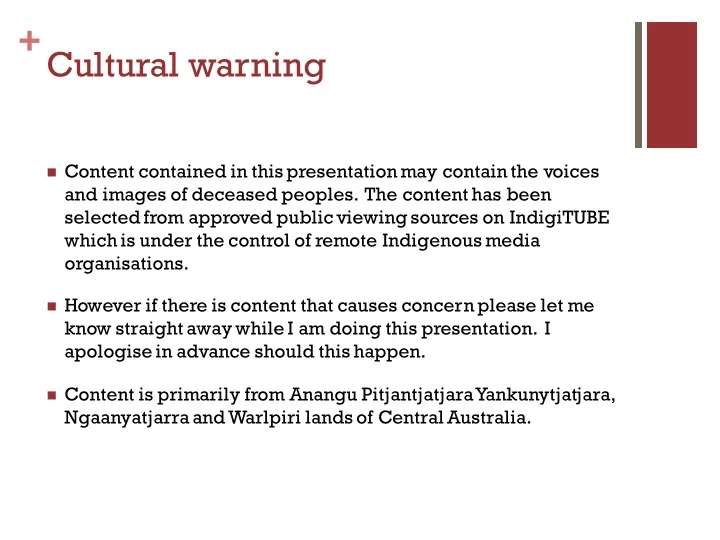

+ Cultural warning n Content contained in this presentation may contain the voices and images of deceased peoples. The content has been selected from approved public viewing sources on IndigiTUBE which is under the control of remote Indigenous media organisations. n However if there is content that causes concern please let me know straight away while I am doing this presentation. I apologise in advance should this happen. n Content is primarily from Anangu Pitjantjatjara Yankunytjatjara, Ngaanyatjarra and Warlpiri lands of Central Australia.
+ Acknowledgement n I pay my respects to the Ngunnawal and Ngambri custodians of the lands on which we are gathering and pay my respects to elders past, present and future of the Ngunnawal and Ngambri nations. n I extend my respect to the nations of the Aboriginal and Torres Strait Islander peoples attending this workshop and to the peoples represented in the content of my presentation.
+ Remote Indigenous Media Archives Its not just about digitisation! Susan Locke, Indigenous Remote Communications Association
+ Susan Locke n Research and Projects Officer of the Indigenous Remote Communications Association. Peak body for remote Indigenous media organisations. n Have been working in the remote Indigenous media sector for 10 years, including 7 years with Warlpiri Media Association at Yuendumu in Central Australia. n Current major project is the development of the National Remote ATSI Audiovisual Collections Plan in collaboration with a wide range of stakeholders and major partners such as the National Film and Sound Archive and the Australian Institute for Aboriginal and Torres Strait Islander Studies.
+ Remote ATSI Media Archives n Primarily producers, rather tcollecting agencies n Create videos, audio recordings, images, paintings, reports. n Some contain donated materials especially photographs n Remote Indigenous Organisations n Remote Indigenous Media Organisations (radio, video, music) n Art Centres n Land Councils n Language and cultural centres n Local government n Types of media n Special projects such as Ara Irititja n Analog and tape formats: VHS/SVHS, n Storage environments Betacam, mini-DV , DV-CAM, DVDs, CDs, reel- to-reel, audiocassettes n Dust, lots and lots of dust n Analog image formats: photos (b&w, colour), n High humidity negatives, slides n High temperatures n Digital formats: whole gamut of formats from n Tape media especially vulnerable digital devices
+ Remote ATSI Archives from the 1970s and continuing into the future n Inma Mimilinya 1989. Mimili, APY Lands. n First Contact animation. 2014. Gurindji/Warlpiri lands. https://vimeo.com/87845 528
+ Staying on-country Ensures that cultural authority and local Indigenous knowledges remain at the heart of remote archival media content. n Remote Indigenous media objects are cultural objects in which are embedded local relationships, cultural, social and historical knowledges. n Keeping archives on country recognises the importance of locality for culturally appropriate management: n Storage protocols such as separate men’s and women business media storage. n Physical access to the archival storage areas as well as handling of media such as family only access, specific clan group access, etc. n Arrangements on what can be seen/listened to, and continuing oversight of opening and closing of media access according to sorry or sensitive protocols. n Workspace arrangements for digitising and cataloguing media – separate rooms for sensitive men’s content, sensitive women’s content. n Metadata approaches that incorporate specific ICIP rights, detailed cultural descriptors. n Community viewing arrangements that manage sorry and sensitive viewing appropriately.
+ And so a Plan, a collaborative Plan! The National Remote Aboriginal and Torres Strait Islander Audiovisual Collections Plan 2014-2016 n Stakeholders identified at a forum in Ntaria (Hermannsburg) in September. n Key stakeholders: Indigenous Remote Communications Association (lead), Remote Indigenous Media Organisations, National Film and Sound Archive, Australian Institute for Aboriginal and Torres Strait Islander Studies, Northern Territory Library, Batchelor Institute, academic researchers including Dr Michael Christie (Charles Darwin University) and Lyndon Ormond-Parker (University of Melbourne), Indigenous Community Television, Strehlow Research Centre, Mulka Project. n Reference group of stakeholders formed: n Input into a basic schema for a Plan n Stakeholder workshop over 3 days in Alice Springs in July 2014 fleshed out the content for the Plan and developed by IRCA into Plan. n Plan launched November 2014 in Canberra n Continuing Working Parties on metadata, digital formats, training and preservation.
+ Goal of the National Remote ATSI Media Collections Plan n To keep archives on-country. n To maintain the cultural and linguistic heritage contained in the archives under appropriate cultural authority. n To contribute to national cultural and linguistic heritage within the context and fluidity of local Indigenous knowledges and protocols. n To contribute to community pride and well-being. n To support inter-generational transmission of knowledge. n To foster culturally appropriate employment opportunities in remote communities. n To build capacity of local Indigenous archive organisations in digitisation, cataloguing and preservation.
+ Where are we up to? n Training workshops: n November 2014 in Canberra. Thank you to both NFSA and AIATSIS n UNESCO funded workshops in Darwin and Alice Springs in May 2015, and in Broome in July 2015. Each location provided 5 day training in preservation, managements, storage, digitisation, formats, metadata, disaster management and more. Thank you to NFSA for significant in-kind support including Mick Newnham’s training expertise.
+ Where are we up to? n Training workshops: n November 2014 in Canberra. Thank you to both NFSA and AIATSIS n UNESCO funded workshops in Darwin and Alice Springs in May 2015, and in Broome in July 2015. Each location provided 5 day training in preservation, managements, storage, digitisation, formats, metadata, disaster management and more. Thank you to NFSA for significant in-kind support including Mick Newnham’s training expertise.
Recommend
More recommend